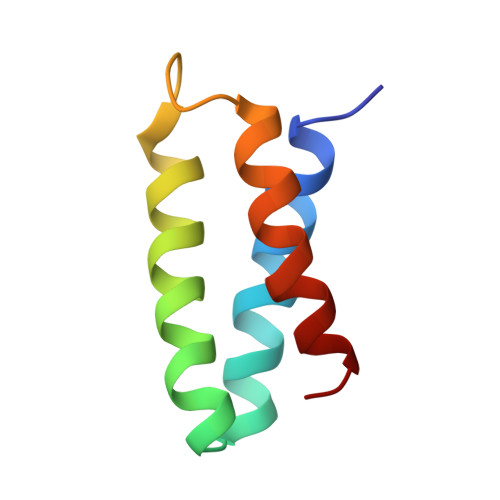Switching the proton-coupled electron transfer mechanism for non-canonical tyrosine residues in a de novo protein.
Nilsen-Moe, A., Reinhardt, C.R., Huang, P., Agarwala, H., Lopes, R., Lasagna, M., Glover, S., Hammes-Schiffer, S., Tommos, C., Hammarstrom, L.(2024) Chem Sci 15: 3957-3970
- PubMed: 38487244
- DOI: https://doi.org/10.1039/d3sc05450k
- Primary Citation of Related Structures:
8VSW - PubMed Abstract:
The proton-coupled electron transfer (PCET) reactions of tyrosine (Y) are instrumental to many redox reactions in nature. This study investigates how the local environment and the thermodynamic properties of Y influence its PCET characteristics. Herein, 2- and 4-mercaptophenol (MP) are placed in the well-folded α 3 C protein (forming 2MP-α 3 C and 4MP-α 3 C) and oxidized by external light-generated [Ru(L) 3 ] 3+ complexes. The resulting neutral radicals are long-lived (>100 s) with distinct optical and EPR spectra. Calculated spin-density distributions are similar to canonical Y˙ and display very little spin on the S-S bridge that ligates the MPs to C 32 inside the protein. With 2MP-α 3 C and 4MP-α 3 C we probe how proton transfer (PT) affects the PCET rate constants and mechanisms by varying the degree of solvent exposure or the potential to form an internal hydrogen bond. Solution NMR ensemble structures confirmed our intended design by displaying a major difference in the phenol OH solvent accessible surface area (≤∼2% for 2MP and 30-40% for 4MP). Additionally, 2MP-C 32 is within hydrogen bonding distance to a nearby glutamate (average O-O distance is 3.2 ± 0.5 Å), which is suggested also by quantum mechanical/molecular mechanical (QM/MM) molecular dynamics simulations. Neither increased exposure of the phenol OH to solvent (buffered water), nor the internal hydrogen bond, was found to significantly affect the PCET rates. However, the lower phenol p K a values associated with the MP-α 3 C proteins compared to α 3 Y provided a sufficient change in PT driving force to alter the PCET mechanism. The PCET mechanism for 2MP-α 3 C and 4MP-α 3 C with moderately strong oxidants was predominantly step-wise PTET for pH values, but changed to concerted PCET at neutral pH values and below when a stronger oxidant was used, as found previously for α 3 Y. This shows how the balance of ET and PT driving forces is critical for controlling PCET mechanisms. The presented results improve our general understanding of amino-acid based PCET in enzymes.
Organizational Affiliation:
Department of Chemistry, Ångström Laboratory, Uppsala University Box 523 75120 Uppsala Sweden leif.hammarstrom@kemi.uu.se.















